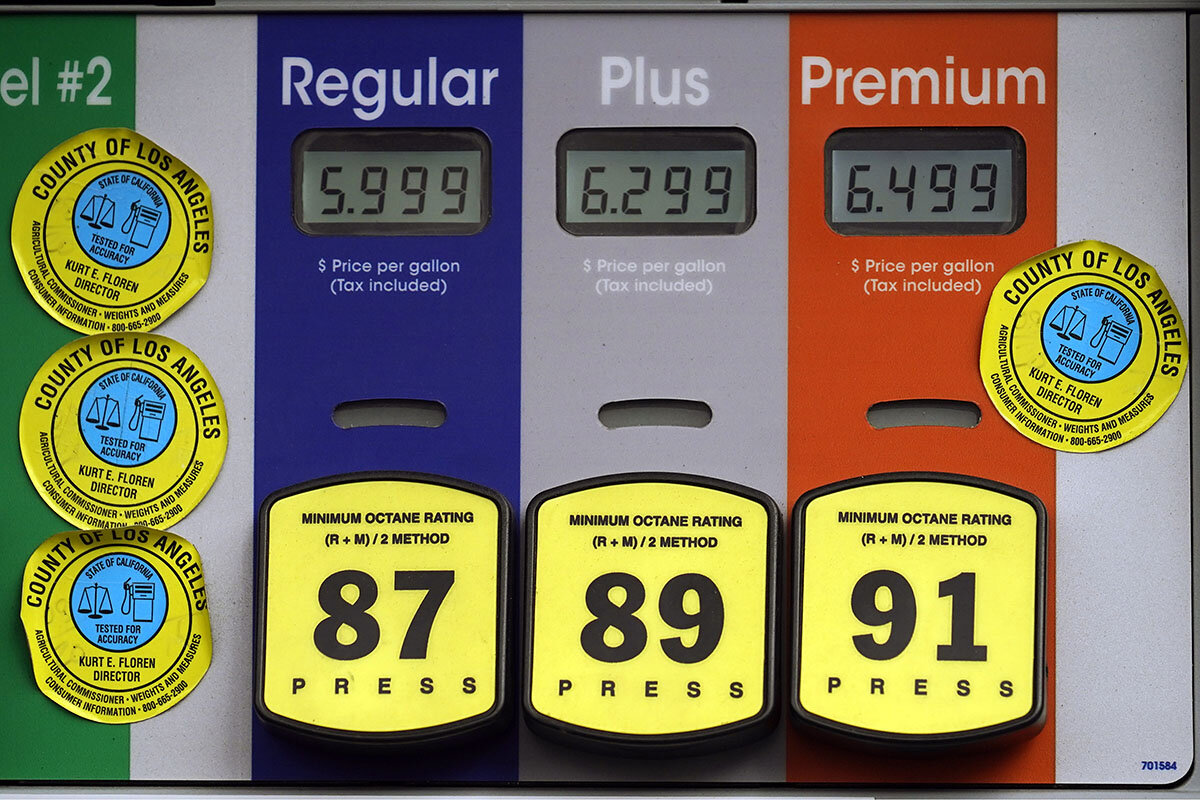Inflation at 30-year high. Where it goes next is (partly) up to you.
Loading...
Inflation hit a 30-year high last month, according to federal data released today. The report from the Bureau of Labor Statistics adds new fuel to growing worries that recent price increases are not a temporary bump but the beginning of high inflation that could last – possibly for years.
American households are being strained by rising prices for everything from food and fuel to rent, child care, and automobiles.
A range of factors are taking some of the blame, from cargo-container traffic jams and constrained energy supplies to coronavirus relief programs that put extra money in consumer pockets.
Why We Wrote This
Many Americans have never lived through severe inflation. Here’s why the answer to today’s worrisome price spike may revolve around consumer and business mindsets, not just kinks in supply chains.
But a basic theme is that, amid an evolving pandemic, consumer demand has rebounded more strongly than the supply of labor and goods. And now the question is, how long will inflation run hot?
The U.S. consumer price index is up 6.2% over the past 12 months, the strongest year-over-year gain since 1990. Wages are also up, by 4.9%, and Social Security benefits will be getting a 5.9% cost-of-living boost come January. Still, that doesn’t allay rising consumer worry. And upward pressure on wages – driven by a tight labor market – can become another reason for price hikes to continue.
Yet many economists are quick to point out several reasons the United States is unlikely to return to an era like the Great Inflation of the 1970s. For one thing, supply chain problems are expected to ease in the new year. The other big factor is the interplay between public expectations and Federal Reserve monetary policy.
One way to put it: The direction of long-term inflation depends partly on you. And that may be a hopeful sign, since public expectations currently aren’t near where they stood at the end of the 1970s.
Why are people worrying about inflation now?
The twin shocks of a national labor shortage and a worldwide pandemic have made some goods scarce and far more expensive than a year ago. Used car and truck prices were up 26% in the period from October 2020 to October 2021. New vehicles were up 10%, and food 5%. Much of the jump came from the energy sector, with gasoline up 50%. But even discounting the volatile sectors of energy and food, inflation over the past year still rose 4.6%, the highest rate since 1991.
Many analysts don’t mind inflation running higher than the Federal Reserve’s 2% target, to make up for the years since the Great Recession, when it was under the target. To others, however, like former Obama administration economic adviser Larry Summers, the handwriting is on the wall. “Until the Fed & Treasury fully recognize the inflation reality, they are unlikely to deal with it successfully,” he wrote in a lengthy tweet last month.
The Federal Reserve has acted preemptively in previous economic shocks, raising interest rates before inflation set in or lowering them in advance of a recession. (Raising interest rates slows the economy because loans cost more, so people and businesses delay making improvements or expanding. Lowering interest rates boosts the economy.)
This time the Fed is moving much more circumspectly. A week ago, the central bank announced it would start reducing its monthly purchase of bonds, which it has been using to support economic growth. This “tapering” would eliminate all that extra economic support by the middle of next year, opening the possibility of interest rate increases starting around late summer.
The latest data may speed up that timetable. “Given that Fed tightening moves are often prompted by market movements, unless inflation cools off very quickly on a sequential basis (which is looking less likely by the day), there would seem to be an increasing chance of the Fed’s hand being forced earlier than it is currently thinking in terms of an initial rate hike,” Joshua Shapiro, chief U.S. economist at consulting firm Maria Fiorini Ramirez, wrote in a note today.
This sharpening debate over whether inflation is transitory, as the Fed says, or longer-lasting has political implications. “Inflation hurts Americans’ pocketbooks, and reversing this trend is a top priority for me,” President Joe Biden said in a statement today after the inflation numbers were released. The president soon has to decide whether to reappoint Fed Chairman Jerome Powell – and signal his support for the Fed’s current direction – or nominate someone else. He also has three other appointments to make soon on the seven-member board.
What do you mean, inflation might depend on me?
To many economists, the persistent low inflation of the past 30 years has been rooted in a basic premise: that expectations of consumers, workers, and businesses are a key driver of what long-term inflation will be.
If they believe that inflation is long-lasting, consumers will buy more in the present, workers will demand higher wages, and firms will raise prices more readily than if they believe inflation is just a temporary jolt caused by a one-time shock to the economy.
“The most important development in monetary economics that I have witnessed over my now-long career has been the recognition that expectations are central to our understanding of the behavior of the aggregate economy,” Columbia Professor Frederic Mishkin, then on Fed’s board of governors, wrote in a 2007 paper.
It turns out that consumers are not particularly good at guessing inflation a year out. But they have been consistently closer to the mark when looking at inflation five years out. In the latest University of Michigan survey of consumers, they predict 6% inflation a year from now, while the Survey of Professional Forecasters pegged it at around 2.4%. Consumers’ five-year inflation outlook has been at 4% or under since the late 1990s – and stands at 3.8% now – a far cry from the 10.9% they recorded in 1980.
Another important group is business owners, because they have to set prices based on their outlook of future costs and their competitors’ future pricing, which of course depends in part on inflation. Firms’ expectations are even more volatile than consumers’, according to data from a new survey. Their outlook for inflation five years out is 4.9%.
Should I be worried?
It’s hard for anyone to take a step back and look at the long-term picture, especially when they’re confronted daily by rising prices at the gas pump, the car dealership, and the grocery store. But there are reasons for optimism.
First, major price rises aren’t across the board; they’re limited to specific goods where demand has outstripped supply.
“The goods that were expensive got a lot more expensive,” says Mark Witte, an economist at Northwestern University in Evanston, Illinois. But “it’s really limited to a few things. ... Whereas if it were every good in the economy getting more expensive, that would be a lot more difficult” to fix.
Also, the supply chain shortages are likely to end. Businesses will find ways to boost supplies of those goods in short supply or find cheaper substitutes for them. Then there’s the pandemic. If it eases, then fear of returning to work is likely to lessen, boosting the flow of workers back to the workplace.
It’s worth remembering, however, that it was a flawed prevailing theory that may, in part, have kept the Fed from acting to stem inflation during the 1970s. The so-called Phillips curve suggested the cost of bringing inflation down was very high. Is the new theory, with its reliance on consumer sentiment, more solid?
One Fed economist caused a stir two months ago by publishing a paper calling into question that central tenet of expectations. “This belief rests on extremely shaky foundations, and a case is made that adhering to it uncritically could easily lead to serious policy errors,” Jeremy Rudd wrote. If the Fed relies too much on consumer expectations, it might miss the economy’s turn toward persistently higher inflation, he warned.
Ultimately, this debate boils down to public confidence in the Fed. If the public believes the central bank can control inflation, the Fed will have a much easier time keeping prices from spiraling out of control, than if it loses that public confidence. Last week, CNBC reported that a survey of millionaires conducted for it found that a majority – 53% – said they agreed with the Fed that inflation was “transitory.” But that was down from 72% the previous quarter.







